Cultural vs. State Borders: Plant Foraging by Hawraman and Mukriyan Kurds in Western Iran
Abstract
1. Introduction
- Document the TEK related to using wild food plants by Mukriyan and Hawraman Kurds in western Iran.
- Compare the wild plants mentioned by the Iranian Hawraman with a previously published study on Iraqi Hawraman.
- Position our results within other studies conducted on cross-cultural ethnobiology and reflect on the differences and commonalities arising from cross-border territories to advance the hypothesis on how the circulation of local plant knowledge happens.
2. Materials and Methods
2.1. Study Area
2.2. Data Collection and Data Analysis
3. Results and Discussion
3.1. Ethnobotanical heritage of Hawramani and Mukriyani Kurds in Iran
3.2. Transitional Knowledge over Cultural Borders: Differences and Similarities between Hawramani and Mukriyani Kurds in Iran
3.3. Transitional knowledge over State Borders: Differences and Similarities between Hawramani in Iran and Hawramani in Iraq
4. Conclusions
Author Contributions
Funding
Data Availability Statement
Acknowledgments
Conflicts of Interest
References
- Sulaiman, N.; Zocchi, D.M.; Borrello, M.T.; Mattalia, G.; Antoniazzi, L.; Berlinghof, S.E.; Bewick, A.; Häfliger, I.; Schembs, M.; Torri, L.; et al. Traditional Knowledge Evolution over Half of a Century: Local Herbal Resources and Their Changes in the Upper Susa Valley of Northwest Italy. Plants 2024, 13, 43. [Google Scholar] [CrossRef] [PubMed]
- Goodman, S.M.; Hobbs, J.J. The ethnobotany of the Egyptian Eastern Desert: A comparison of common plant usage between two culturally distinct Bedouin groups. J. Ethnopharmacol. 1988, 23, 73–89. [Google Scholar] [CrossRef] [PubMed]
- Jan, H.A.; Mir, T.A.; Bussmann, R.W.; Jan, M.; Hanif, U.; Wali, S. Cross-cultural ethnomedicinal study of the wild species of the genus Berberis used by the ethnic communities living along both sides of the Indo-Pak border in Kashmir. Ethnobot. Res. Appl. 2023, 26, 1–14. [Google Scholar] [CrossRef]
- Ghirardini, M.P.; Carli, M.; Del Vecchio, N.; Rovati, A.; Cova, O.; Valigi, F.; Agnetti, G.; Macconi, M.; Adamo, D.; Traina, M.; et al. The importance of a taste. A comparative study on wild food plant consumption in twenty-one local communities in Italy. J. Ethnobiol. Ethnomedicine 2007, 3, 22. [Google Scholar] [CrossRef]
- Haq, S.M.; Waheed, M.; Khoja, A.A.; Amjad, M.S.; Bussmann, R.W.; Ali, K. A cross-cultural study of high-altitude botanical resources among diverse ethnic groups in Kashmir Himalaya, India. J. Ethnobiol. Ethnomedicine 2023, 19, 12. [Google Scholar] [CrossRef] [PubMed]
- Kunwar, R.M.; Fadiman, M.; Cameron, M.; Bussmann, R.W.; Thapa-Magar, K.B.; Rimal, B.; Sapkota, P. Cross-cultural comparison of plant use knowledge in Baitadi and Darchula districts, Nepal Himalaya. J. Ethnobiol. Ethnomedicine 2018, 14, 40. [Google Scholar] [CrossRef]
- Huxtable, R.J. Ethnopharmacology and ethnobotany along the US-Mexican border: Potential problems with cross-cultural “borrowings”. Proc. West. Pharmacol. Soc 1998, 41, 259–264. [Google Scholar]
- Mattalia, G.; Stryamets, N.; Pieroni, A.; Sõukand, R. Knowledge transmission patterns at the border: Ethnobotany of Hutsuls living in the Carpathian Mountains of Bukovina (SW Ukraine and NE Romania). J. Ethnobiol. Ethnomedicine 2020, 16, 41. [Google Scholar] [CrossRef] [PubMed]
- Kazancı, C.; Oruç, S.; Mosulishvili, M. Medicinal ethnobotany of wild plants: A cross-cultural comparison around Georgia-Turkey border, the Western Lesser Caucasus. J. Ethnobiol. Ethnomedicine 2020, 16, 71. [Google Scholar] [CrossRef]
- DiGe Project. European Research Council-Funded. Available online: https://cordis.europa.eu/project/id/714874 (accessed on 6 January 2024).
- Mattalia, G.; Prakofjewa, J.; Kalle, R.; Prūse, B.; Marozzi, M.; Stryamets, N.; Kuznetsova, N.; Belichenko, O.; Aziz, M.; Pieroni, A.; et al. Centralization can jeopardize local wild plant-based food security. NJAS Impact Agric. Life Sci. 2023, 95, 2191798. [Google Scholar] [CrossRef]
- Haq, S.M.; Hassan, M.; Jan, H.A.; Al-Ghamdi, A.A.; Ahmad, K.; Abbasi, A.M. Traditions for future cross-national food security—Food and foraging practices among different native communities in the Western Himalayas. Biology 2022, 11, 455. [Google Scholar] [CrossRef]
- Mir, T.A.; Jan, M.; Jan, H.A.; Bussmann, R.W.; Sisto, F.; Fadlalla, I.M.T. A Cross-Cultural Analysis of Medicinal Plant Utilization among the Four Ethnic Communities in Northern Regions of Jammu and Kashmir, India. Biology 2022, 11, 1578. [Google Scholar] [CrossRef]
- Khoja, A.A.; Andrabi, S.A.H.; Mir, R.A.; Bussmann, R.W. Ethnobiological uses of plant species among three ethnic communities in the administrative (Kupwara) of Jammu and Kashmir-India: A cross cultural Analysis. Ethnobot. Res. Appl. 2022, 24, 1–22. [Google Scholar] [CrossRef]
- Stryamets, N.; Mattalia, G.; Pieroni, A.; Khomyn, I.; Sõukand, R. Dining Tables Divided by a Border: The Effect of Socio-Political Scenarios on Local Ecological Knowledge of Romanians Living in Ukrainian and Romanian Bukovina. Foods 2021, 10, 126. [Google Scholar] [CrossRef]
- Pieroni, A.; Zahir, H.; Amin, H.I.M.; Sõukand, R. Where tulips and crocuses are popular food snacks: Kurdish traditional foraging reveals traces of mobile pastoralism in Southern Iraqi Kurdistan. J. Ethnobiol. Ethnomedicine 2019, 15, 59. [Google Scholar] [CrossRef]
- Kunwar, R.M. Ethnobotany in the Kailash Sacred Landscape, Nepal: Implications for Conservation through Interactions of Plants, People, Culture and Geography. Doctoral Dissertation, Florida Atlantic University, Boca Raton, FL, USA, 2018. Available online: https://www.proquest.com/openview/f8da6e511feff729bbc0732442918436/1?pq-origsite=gscholar&cbl=18750 (accessed on 25 February 2024).
- Waheed, M.; Haq, S.M.; Arshad, F.; Bussmann, R.W.; Pieroni, A.; Mahmoud, E.A.; Casini, R.; Yessoufou, K.; Elansary, H.O. Traditional Wild Food Plants Gathered by Ethnic Groups Living in Semi-Arid Region of Punjab, Pakistan. Biology 2023, 12, 269. [Google Scholar] [CrossRef]
- Paniagua-Zambrana, N.Y.; Camara-Lerét, R.; Bussmann, R.W.; Macía, M.J. The influence of socioeconomic factors on traditional knowledge: A cross scale comparison of palm use in northwestern South America. Ecol. Soc. 2014, 19, 9. [Google Scholar] [CrossRef]
- Prakofjewa, J.; Sartori, M.; Šarka, P.; Kalle, R.; Pieroni, A.; Sõukand, R. Boundaries Are Blurred: Wild Food Plant Knowledge Circulation across the Polish-Lithuanian-Belarusian Borderland. Biology 2023, 12, 571. [Google Scholar] [CrossRef] [PubMed]
- Sulaiman, N.; Pieroni, A.; Sõukand, R.; Whitney, C.; Polesny, Z. Socio-Cultural Significance of Yerba Maté among Syrian Residents and Diaspora. Econ. Bot. 2021, 75, 97–111. [Google Scholar] [CrossRef]
- UNESCO. 2021. Available online: https://whc.unesco.org/en/list/1647 (accessed on 19 January 2024).
- Pieroni, A.; Ahmed, H.M.; Zahir, H. The spring has arrived: Traditional wild vegetables gathered by Yarsanis (Ahl-e Haqq) and Sunni Muslims in Western Hawraman, SE Kurdistan (Iraq). Acta Soc. Bot. Pol. 2017, 86, 3519. [Google Scholar] [CrossRef]
- Academic Accelerator. Available online: https://academic-accelerator.com/encyclopedia/mukriyan (accessed on 9 February 2024).
- Dolores, M.; Tongco, C. Purposive Sampling as a Tool for Informant Selection. Ethnobot. Res. Appl. 2007, 5, 147–158. [Google Scholar]
- ISE (International Society of Ethnobiology). Code of Ethics. 2008. Available online: https://www.ethnobiology.net/wp-content/uploads/ISE-COE_Eng_rev_24Nov08.pdf (accessed on 9 February 2024).
- Cabrera-Meléndez, J.L.; Iparraguirre-León, D.; Way, M.; Valenzuela-Oré, F.; Montesinos-Tubée, D.B. The applicability of similarity indices in an ethnobotanical study of medicinal plants from three localities of the Yunga district, Moquegua region, Peru. Ethnobot. Res. Appl. 2022, 24, 1–18. [Google Scholar] [CrossRef]
- Sulaiman, N.; Pieroni, A.; Sõukand, R.; Polesny, Z. Food Behavior in Emergency Time: Wild Plant Use for Human Nutrition during the Conflict in Syria. Foods 2022, 11, 177. [Google Scholar] [CrossRef]
- Ali-Shtayeh, M.S.; Jamous, R.M.; Al-Shafie, J.H.; Wafa’A, E.; Kherfan, F.A.; Qarariah, K.H.; Isra’S, K.; Soos, I.M.; Musleh, A.A.; Isa, B.A.; et al. Traditional knowledge of wild edible plants used in Palestine (Northern West Bank): A comparative study. J. Ethnobiol. Ethnomed. 2008, 4, 13. [Google Scholar] [CrossRef]
- Sulaiman, N.; Aziz, M.A.; Stryamets, N.; Mattalia, G.; Zocchi, D.M.; Ahmed, H.M.; Manduzai, A.K.; Shah, A.A.; Faiz, A.; Sõukand, R.; et al. The Importance of Becoming Tamed: Wild Food Plants as Possible Novel Crops in Selected Food-Insecure Regions. Horticulturae 2023, 9, 171. [Google Scholar] [CrossRef]
- Güneş, S.; Savran, A.; Paksoy, M.Y.; Çakılcıoğlu, U. Survey of wild food plants for human consumption in Karaisalı (Adana-Turkey). Indian J. Tradit. Knowl. 2018, 17, 290–298. [Google Scholar]
- Pieroni, A.; Sõukand, R.; Amin, H.I.M.; Zahir, H.; Kukk, T. Celebrating multi-religious co-existence in Central Kurdistan: The bio-culturally diverse traditional gathering of wild vegetables among Yazidis, Assyrians, and Muslim Kurds. Hum. Ecol. 2018, 46, 217–227. [Google Scholar] [CrossRef]
- Nanagulyan, S.; Zakaryan, N.; Kartashyan, N.; Piwowarczyk, R.; Łuczaj, Ł. Wild plants and fungi sold in the markets of Yerevan (Armenia). J. Ethnobiol. Ethnomedicine 2020, 16, 26. [Google Scholar] [CrossRef]
- Hawramani. Available online: https://hawramani.com/on-the-different-origins-of-kurds-hawramis-and-zaza-people/ (accessed on 30 January 2024).
- Belichenko, O.; Kolosova, V.; Melnikov, D.; Kalle, R.; Sõukand, R. Language of Administration as a Border: Wild Food Plants Used by Setos and Russians in Pechorsky District of Pskov Oblast, NW Russia. Foods 2021, 10, 367. [Google Scholar] [CrossRef]
- Bussmann, R.W.; Paniagua Zambrana, N.Y.; Ur Rahman, I.; Kikvidze, Z.; Sikharulidze, S.; Kikodze, D.; Tchelidze, D.; Khutsishvili, M.; Batsatsashvili, K. Unity in diversity—Food plants and fungi of Sakartvelo (Republic of Georgia), Caucasus. J. Ethnobiol. Ethnomedicine 2021, 17, 72. [Google Scholar] [CrossRef]
- Bussmann, R.W.; Paniagua-Zambrana, N.Y.; Sikharulidze, S.; Kikvidze, Z.; Kikodze, D.; Tchelidze, D.; Batsatsashvili, K.; Hart, R.E. An ethnobotany of Upper Imereti, Ukana Pshavi, Meshketi and Pankisi gorge, Sakartvelo (Republic of Georgia), Caucasus. Bocconea 2021, 29, 33–54. [Google Scholar]
- Marouf, M.; Batal, M.; Moledor, S.; Talhouk, S.N. Exploring the Practice of Traditional Wild Plant Collection in Lebanon. Food Cult. Soc. 2015, 18, 355–378. [Google Scholar] [CrossRef]
- Pieroni, A.; Sulaiman, N.; Polesny, Z.; Sõukand, R. From Şxex to Chorta: The Adaptation of Maronite Foraging Customs to the Greek Ones in Kormakitis, Northern Cyprus. Plants 2022, 11, 2693. [Google Scholar] [CrossRef] [PubMed]
- Pieroni, A.; Sõukand, R. Are borders more important than geographical distance? The wild food ethnobotany of the Boykos and its overlap with that of the Bukovinian Hutsuls in Western Ukraine. J. Ethnobiol. 2017, 37, 326–345. [Google Scholar] [CrossRef]
- Glottolog. Available online: https://glottolog.org/resource/languoid/id/hawr1243 (accessed on 9 February 2024).
- Ethnologue. Available online: https://www.ethnologue.com/subgroup/3/ (accessed on 9 February 2024).
- Vitasović-Kosić, I.; Kaligarič, M.; Juračak, J. Divergence of Ethnobotanical Knowledge of Slovenians on the Edge of the Mediterranean as a Result of Historical, Geographical and Cultural Drivers. Plants 2021, 10, 2087. [Google Scholar] [CrossRef]
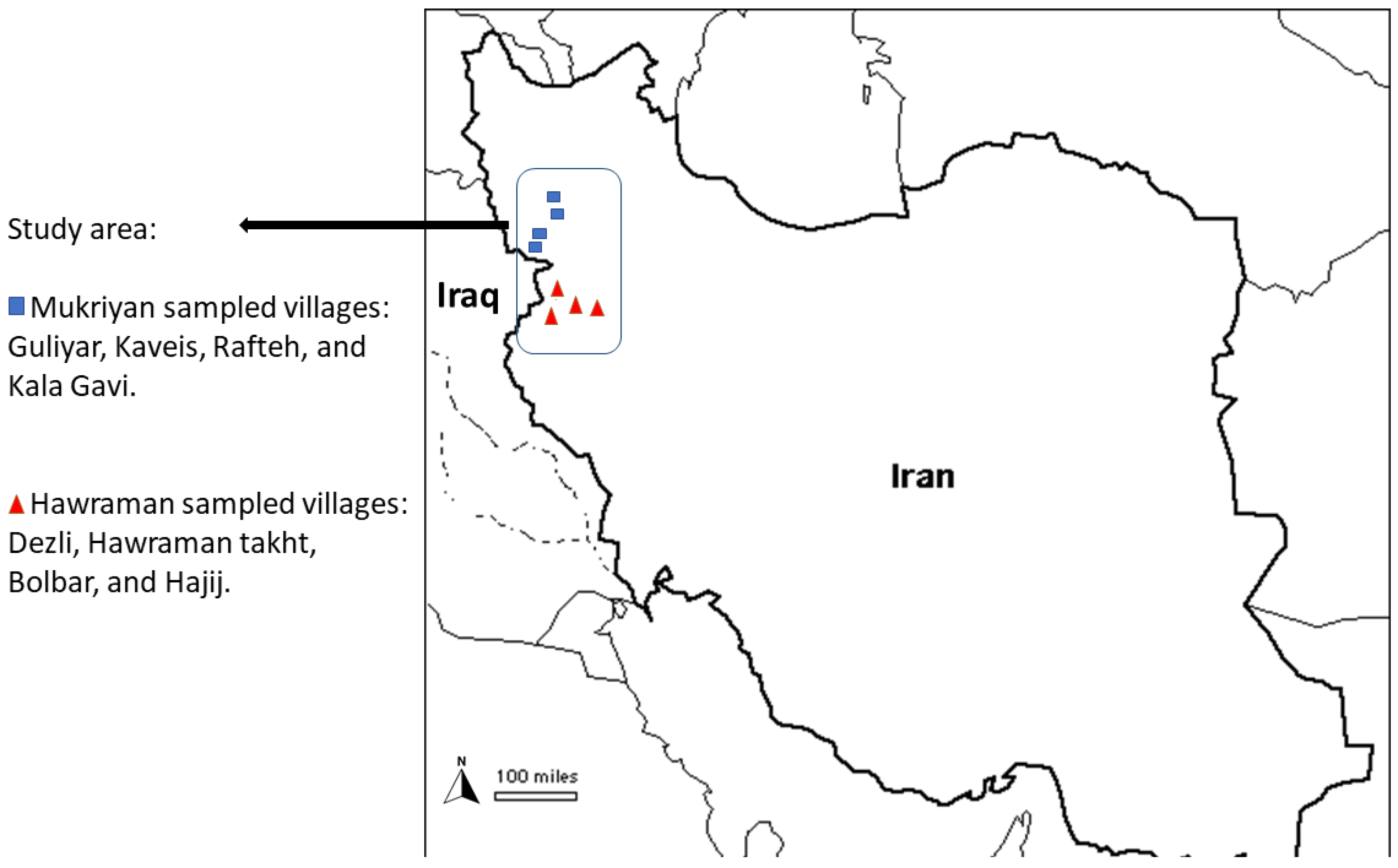
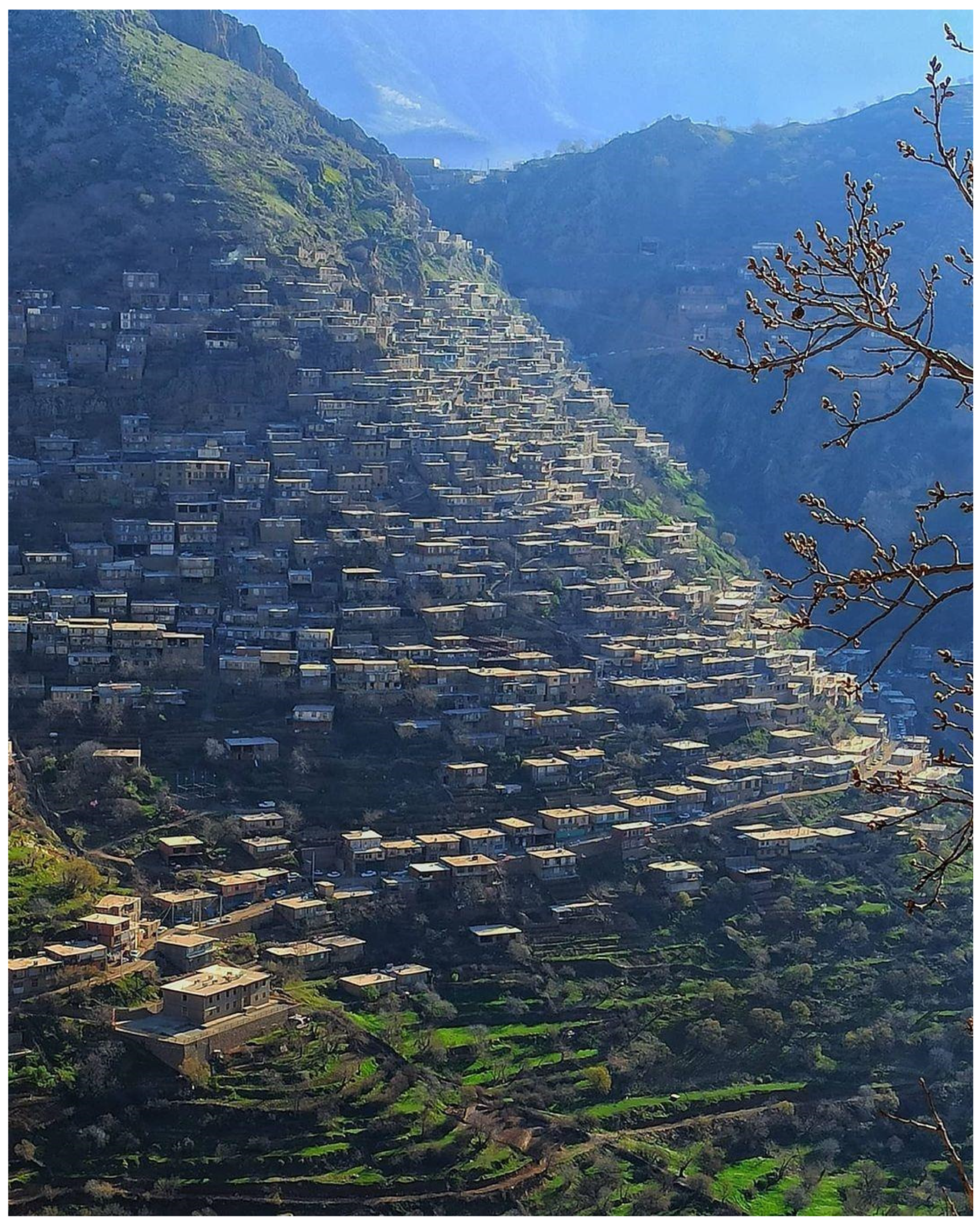
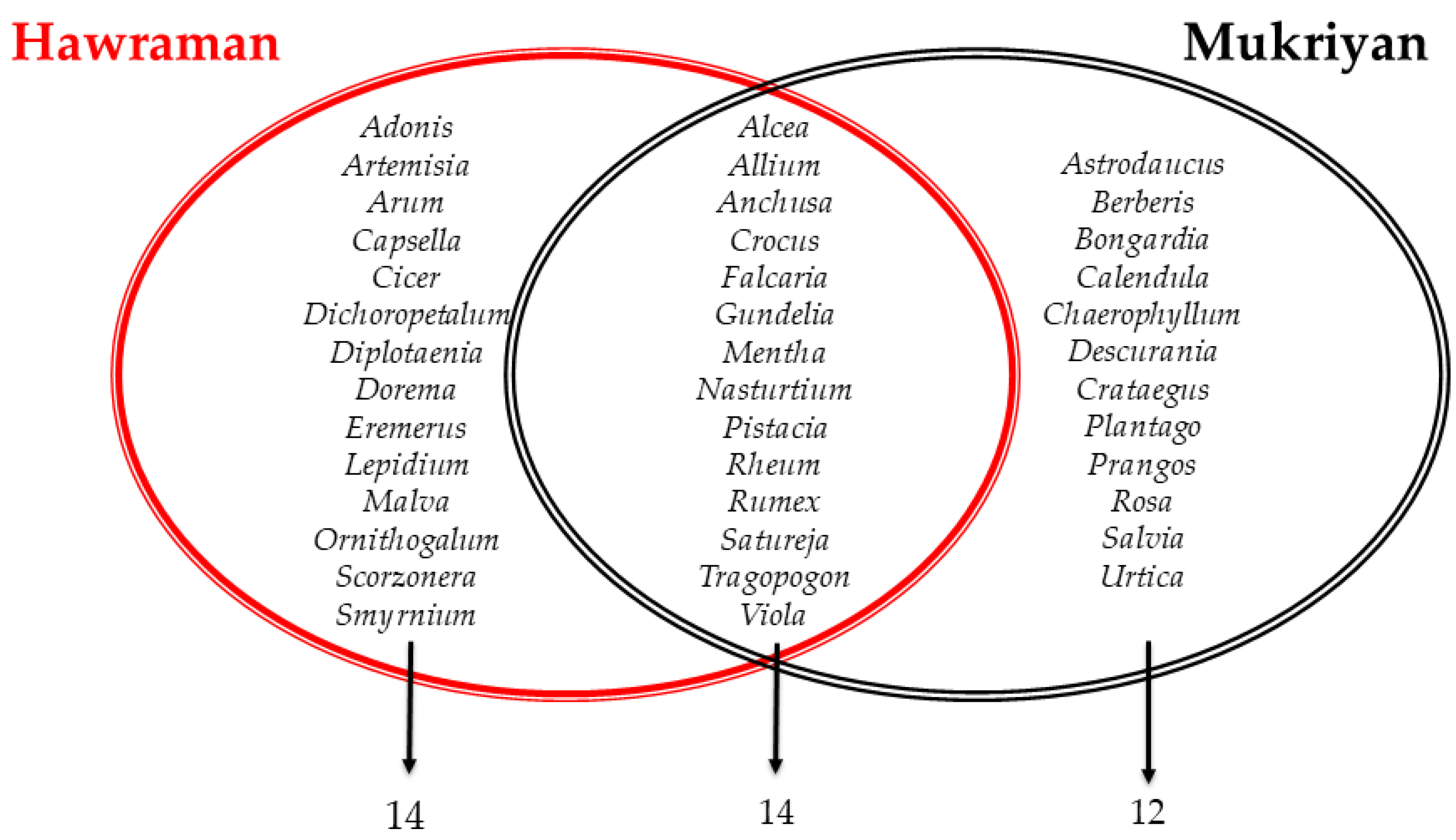
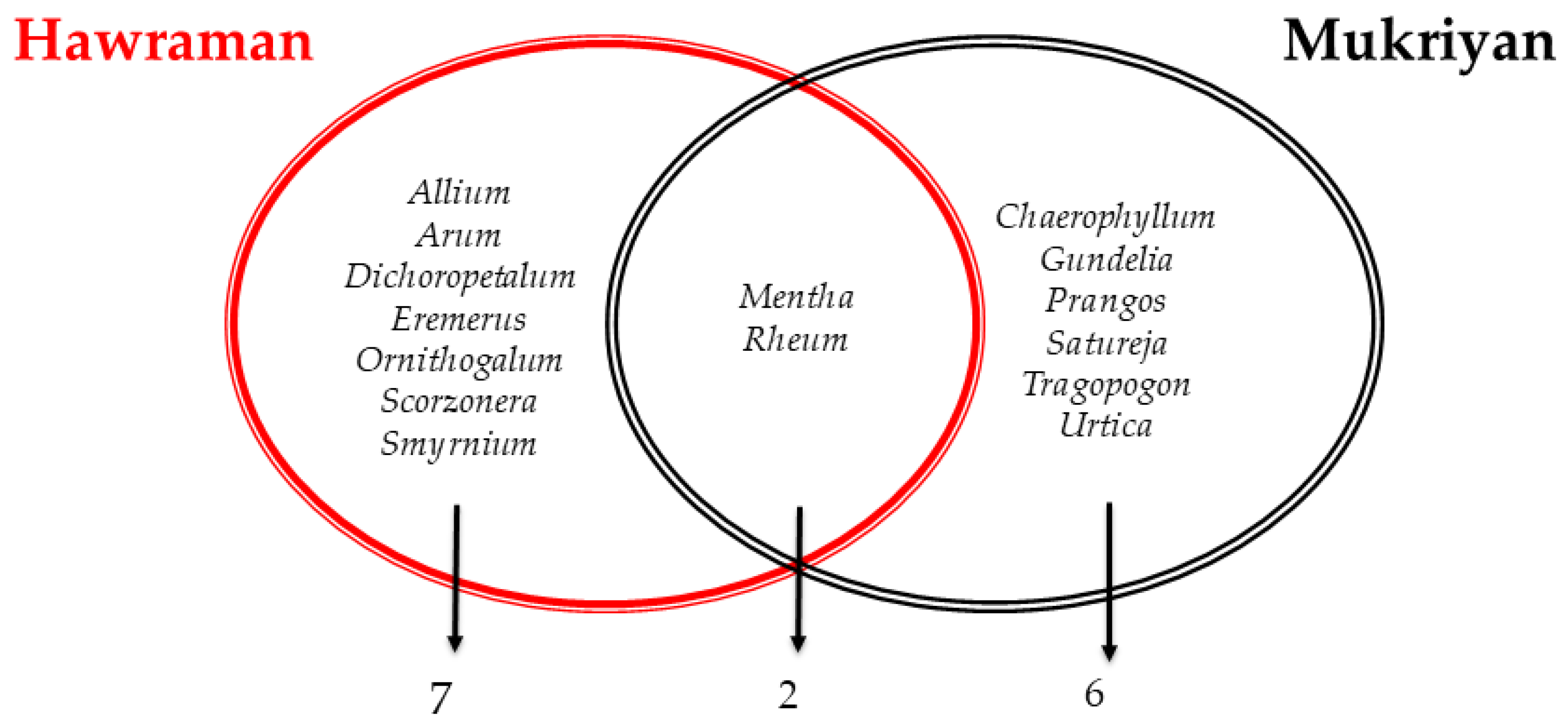
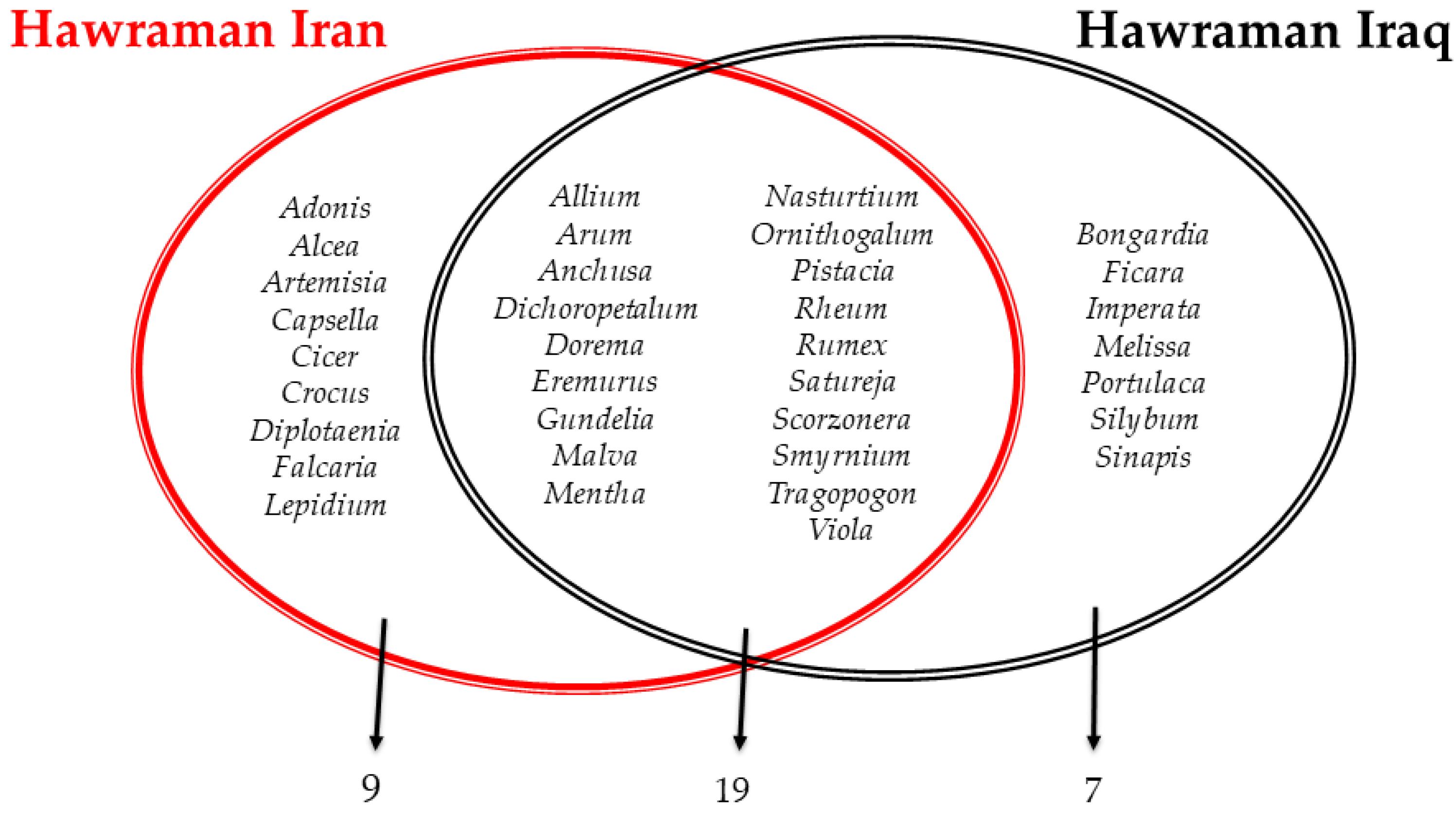
| Scientific Name; Family; Voucher Code | Local Name(s) | Part Used | Local Food Use | Frequency of Citation (FoC) by both Mukriyan and Hawraman in Iran | Reported by Mukriyani Kurds in Iran (FoC) | Reported by Hawramani Kurds in Iran (FoC) | Reported by Hawramani Kurds in Iraq [23] |
|---|---|---|---|---|---|---|---|
| Adonis aestivalis L.; Ranuncolaceae HSK52 | Seiraian | Young aerial parts | Boiled, fried | 2 | No | Yes (2) | No |
| Alcea kurdica (Schltdl.) Alef.; Malvaceae; HSK44 | Harmalei | Leaves and flowers | Soups, tea | 5 | Yes (3) | Yes (2) | No |
| Allium iranicum (Wendelbo) Wendelbo; Amaryllidaceae; HSK48 | Kanival, Knivali | Aerial parts | Seasoning bread (mixed with the dough before baking it) | 5 | No | Yes (5) | No |
| Allium jesdianum Boiss. and Buhse; Amaryllidaceae; HSK09 | Surkabna | Whole plant | Soup | 15 | Yes (4) | Yes (11) | Yes |
| Allium paradoxum (M. Bieb.) G. Don; Amaryllidaceae; HSK40 | Pichek | Leaves | Raw, soups, seasoning (esp. bread) | 24 | Yes (3) | Yes (21) | Yes |
| Anchusa italica Retz.; Boraginaceae; HSK19 | Gozirvan, Gozorvaneh | Flowers | Seasoning, fried, tea | 9 | Yes (3) | Yes (6) | Yes |
| Artemisia annua L. Asteraceae; HSK57 | Barzalang | Leaves | Tea, seasoning yoghurt | 1 | No | Yes (1) | No |
| Arum maculatum L. and possibly other Arum spp. Araceae; HSK50 | Kardu, Khaz | Aerial parts | Soups, stewed | 7 | No | Yes (7) | Yes |
| Astrodaucus orientalis (L.) Drude; Apiaceae; HSK13 | Zizra manda | Stems | Raw | 5 | Yes (5) | No | No |
| Berberis vulgaris L.; Berberidaceae; HSK33 | Zereshk | Fruits | Soups | 1 | Yes (1) | No | No |
| Bongardia chrysogonum (L.) Spach; Berberidaceae; HSK54 | Gable | Young inflorescences | Stewed | 3 | Yes (3) | No | Yes |
| Calendula officinalis L.; Asteraceae; HSK22 | Hamisha bahara | Flowers | Raw, fried, jam | 3 | Yes (3) | No | No |
| Capsella bursa-pastoris (L.) Medik.; Brassicaceae; HSK53 | Paklachaka | Leaves | Soups, fried | 2 | No | Yes (2) | No |
| Chaerophyllum macrospermum (Willd. ex Schult.) Fisch. and C.A.Mey. ex Hohen.; Apiaceae; HSK01 | Mandok | Aerial parts | Soups, pickled | 13 | Yes (13) | No | No |
| Cicer kermanense Bornm.; Fabaceae; HSK20 | Nokashoana | Flowers | Soups | 1 | No | Yes (1) | No |
| Crataegus azarolus L.; Rosaceae; HSK15 | Jevzh | Fruits | Snack | 1 | Yes (1) | No | No |
| Crocus haussknechtii (Boiss. and Reut. ex Maw) Boiss. and possibly other Crocus spp.; Iridaceae; HSK23 | Kifok, Pishok | Corms | Snack, roasted, added to milk | 7 | Yes (3) | Yes (4) | No |
| Descurainia sophia (L.) Webb ex Prantl; Brassicaceae; HSK29 | Shivaran | Leaves | Tea, drunk cold | 1 | Yes (1) | No | No |
| Dichoropetalum aromaticum (Rech.f.) Pimenov and Kljuykov; Apiaceae; HSK37 | Baraza | Aerial parts | Raw, rarely seasoning | 7 | No | Yes (7) | No |
| Diplotaenia damavandica Mozaff., Hedge and Lamond; Apiaceae; HSK55 | Gzlki | Roots | Seasoning | 1 | No | Yes (1) | No |
| Dorema aucheri Boiss.; Apiaceae | Bana | Young aerial parts | Raw, fried | 4 | No | Yes (4) | Yes |
| Eremurus spectabilis M.Bieb.; Asphodelaceae; HSK39 | Khuzha, Khuzhe | Leaves | Raw, soups, seasoning | 17 | No | Yes (17) | Yes |
| Falcaria vulgaris Bernh.; Apiaceae; HSK07 | Kaziakha | Leaves | Raw, soups, stewed | 8 | Yes (4) | Yes (4) | No |
| Gundelia tournefortii L. Asteraceae; HSK02 | Kinger | Stems | Soups, fried | 13 | Yes (9) | Yes (4) | Yes |
| Lepidium persicum Boiss.; Brassicaceae; HSK28 | Hazba koilai, hazba kevialla | Aerial parts | Consumed fresh, boiled, seasoning, tea | 6 | No | Yes (6) | No |
| Malva spp.; Malvaceae | Tollaka | Leaves | Cooked | 4 | No | Yes (4) | Yes |
| Mentha arvensis L.; Lamiaceae; HSK17 | Nana | Leaves | Seasoning | 2 | Yes (2) | No | No |
| Mentha longifolia (L.) L.; Lamiaceae; HSK04 | Pinga | Aerial parts | Raw, seasoning | 29 | Yes (23) | Yes (6) | Yes |
| Mentha requienii Benth.; Lamiaceae; HSK36 | Karas | Aerial parts | Raw, tea | 8 | No | Yes (8) | No |
| Nasturtium officinale W.T.Aiton; Brassicaceae; HSK27 | Kuzala, Kashala | Aerial parts | Raw, soups | 11 | Yes (7) | Yes (4) | Yes |
| Ornithogalum caudatum Aiton and possibly other Ornithogalum spp.; Asparagaceae; HSK41 | Ruzka, Gelakh | Bulbs | Stewed | 6 | No | Yes (6) | Yes |
| Pistacia atlantica Desf.; Anacardiaceae; HSK49 | Kaswan | Unripe fruits and soft stems | Seasoning, pickled | 6 | Yes (3) | Yes (3) | No |
| Plantago major L.; Plantaginaceae; HSK25 | Jia barkholah | Leaves | Snack | 1 | Yes (1) | No | No |
| Prangos aricakensis Behçet and Yapar; Apiaceae; HSK14 | Biza | Leaves | Snack, seasoning cheese, soups | 14 | Yes (14) | No | No |
| Rheum ribes L.; Polygonaceae; HSK03, HSK42 | Revas | Stems | Snack, jams, soups, fried, tea | 33 | Yes (9) | Yes (24) | Yes |
| Rosa canina L.; Rosaceae; HSK34 | Bagh | Flowers | Jam | 1 | Yes (1) | No | No |
| Rumex spp.; Polygonaceae; HSK35 | Tirshoka, Tisho | Leaves and stems | Raw, soups | 11 | Yes (5) | Yes (6) | Yes |
| Salvia bracteata Banks and Sol.; Lamiaceae; HSK24 | Jia chai | Aerial parts | Tea | 2 | Yes (2) | No | No |
| Satureja spp.; Lamiaceae | Jatrah, Kashmah | Leaves | Seasoning | 16 | Yes (10) | Yes (6) | Yes |
| Scorzonera sp.; Asteraceae; HSK21 | Shing | Aerial parts | Raw, fried | 10 | No | Yes (10) | Yes |
| Smyrnium cordifolium Boiss.; Apiaceae; HSK46 | Gnur, Ninur | Stems, leaves | Raw, seasoning (also black tea) | 10 | No | Yes (10) | Yes |
| Tragopogon collinus DC. and possibly other Tragopogon spp.; Asteraceae; HSK21 | Halakok, Asping | Leaves | Raw, fried | 21 | Yes (16) | Yes (5) | Yes |
| Urtica spp.; Urticaceae; HSK05 | Gazgask | Young aerial parts | Soups, stewed, tea | 9 | Yes (9) | No | No |
| Viola cornuta L.; Violaceae; HSK43 | Vanavshah | Flowers | Tea, jams | 8 | Yes (2) | Yes (6) | No |
| Hawramani | Mukriyani |
|---|---|
| Rheum ribes (24) | Mentha longifolia (23) |
| Allium paradoxum (21) | Tragopogon collinus (16) |
| Eremurus spectabilis (17) | Prangos aricakensis (14) |
Disclaimer/Publisher’s Note: The statements, opinions and data contained in all publications are solely those of the individual author(s) and contributor(s) and not of MDPI and/or the editor(s). MDPI and/or the editor(s) disclaim responsibility for any injury to people or property resulting from any ideas, methods, instructions or products referred to in the content. |
© 2024 by the authors. Licensee MDPI, Basel, Switzerland. This article is an open access article distributed under the terms and conditions of the Creative Commons Attribution (CC BY) license (https://creativecommons.org/licenses/by/4.0/).
Share and Cite
Sulaiman, N.; Salehi, F.; Prakofjewa, J.; Cavalleri, S.A.E.; Ahmed, H.M.; Mattalia, G.; Rastegar, A.; Maghsudi, M.; Amin, H.M.; Rasti, A.; et al. Cultural vs. State Borders: Plant Foraging by Hawraman and Mukriyan Kurds in Western Iran. Plants 2024, 13, 1048. https://doi.org/10.3390/plants13071048
Sulaiman N, Salehi F, Prakofjewa J, Cavalleri SAE, Ahmed HM, Mattalia G, Rastegar A, Maghsudi M, Amin HM, Rasti A, et al. Cultural vs. State Borders: Plant Foraging by Hawraman and Mukriyan Kurds in Western Iran. Plants. 2024; 13(7):1048. https://doi.org/10.3390/plants13071048
Chicago/Turabian StyleSulaiman, Naji, Farzad Salehi, Julia Prakofjewa, Sofia Anna Enrica Cavalleri, Hiwa M. Ahmed, Giulia Mattalia, Azad Rastegar, Manijeh Maghsudi, Hawraz M. Amin, Ahmad Rasti, and et al. 2024. "Cultural vs. State Borders: Plant Foraging by Hawraman and Mukriyan Kurds in Western Iran" Plants 13, no. 7: 1048. https://doi.org/10.3390/plants13071048
APA StyleSulaiman, N., Salehi, F., Prakofjewa, J., Cavalleri, S. A. E., Ahmed, H. M., Mattalia, G., Rastegar, A., Maghsudi, M., Amin, H. M., Rasti, A., Hosseini, S. H., Ghorbani, A., Pieroni, A., & Sõukand, R. (2024). Cultural vs. State Borders: Plant Foraging by Hawraman and Mukriyan Kurds in Western Iran. Plants, 13(7), 1048. https://doi.org/10.3390/plants13071048









